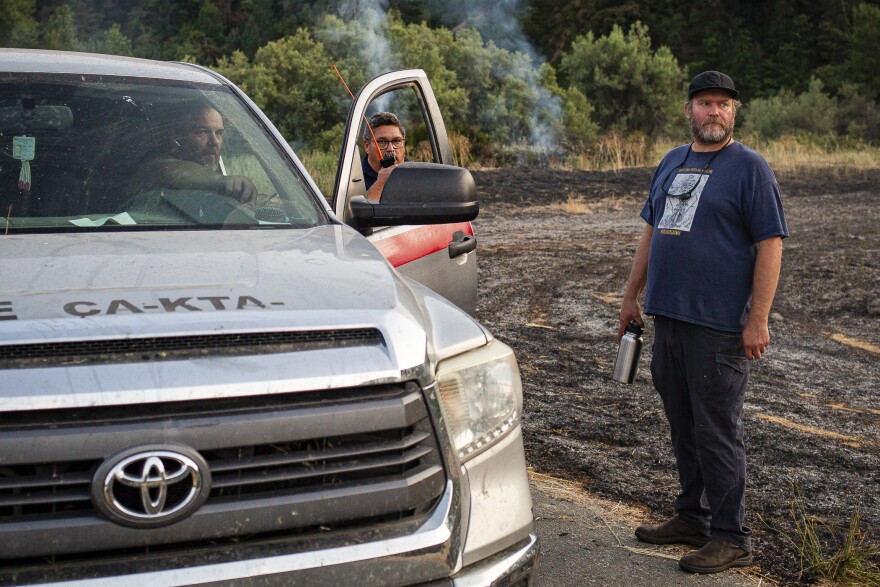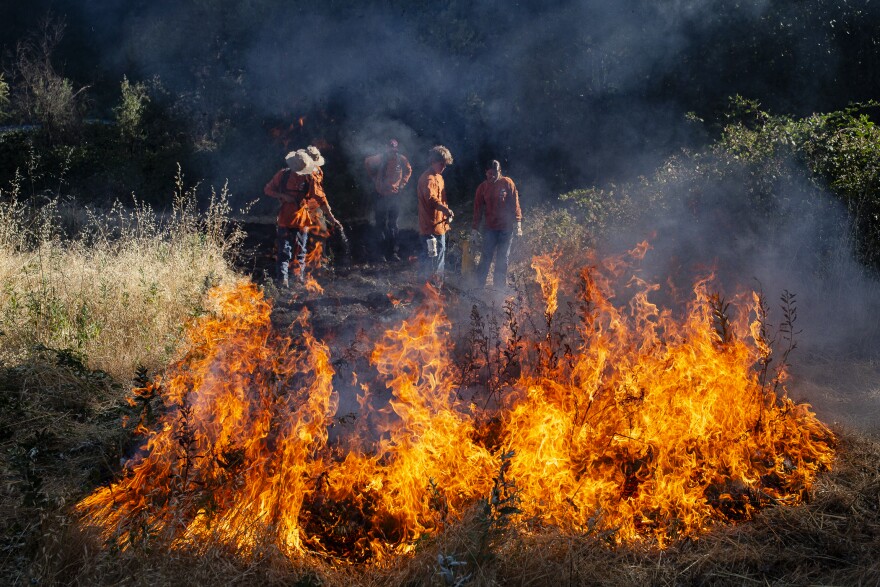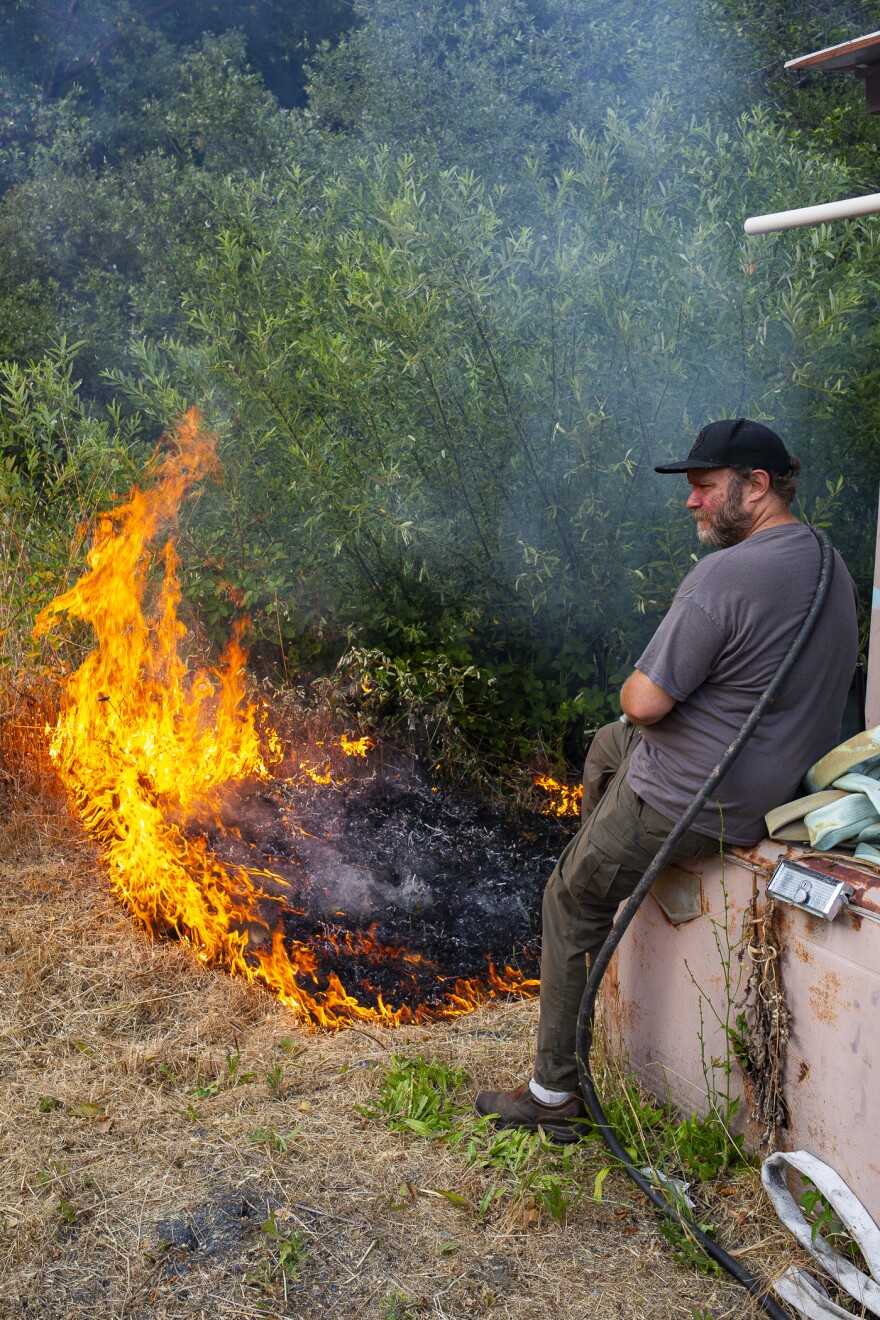On a late June afternoon in the remote Northern California town of Orleans, Michael Sanchez hopped into a wildland fire truck. He’s the prescribed fire and fuel specialist for the Karuk Tribe, and helps organize their cultural burns, including the three planned that day.
“One of the burns is my house,” he said. “So I've been kind of taking the main lead on preparing that.”

While small, the burns represent a major step forward in the tribe’s longstanding effort to promote cultural burning. It’s the fruit of years of advocacy, and collaboration with federal agencies and nonprofits to bring down barriers to it.
In 2022, California established a claims fund to reduce the financial risk when fires set by landowners and tribes cause damage. Then last fall, Senate Bill 310 (S.B. 310) was unanimously passed and signed. It allows federally recognized tribes to enter into agreements with the state’s natural resources agency to bypass permitting and regulatory requirements in order to conduct cultural burns.
In a 2024 op-ed, Karuk Chairman Russell Attebery said state and federal authorities tried “to stamp out” Indigenous burning well into the 20th century. He called S.B. 310 “an opportunity for California to ‘walk the walk’ when it comes to healing and reconciliation of a violent history towards Indigenous peoples and the misguided exclusion of fire.”
Burning as ‘cultural norm’
Heading west on the Klamath River Highway toward the edge of town, Sanchez drove past an orange sign advising motorists of the planned cultural burns. S.B. 310 has made burning much simpler, he said.
“You see the sign right here? That's one of the requirements,” he explained. “And then also a 72-hour notification to local agencies, Forest Service, volunteer [fire].”
There are a few other steps - like getting written permission from landowners and sharing burn locations - but that’s about it.
The first burn of the day was in the backyard of a home kitty corner from Sanchez’s. Using lighters, a trio of Karuk men set the dry grass and dead leaves ablaze, and kept it in check with a simple hose.
Standing watch, Bill Tripp, the Tribe’s director of natural resources and one of the country’s most prominent cultural burning advocates, said the fires will help protect homes.
“Today we're just trying to get rid of this stuff that's going to catch an ember and start a spot fire in the summer,” he said. “At a time when it won’t create spot fires by burning it.”

Bill was taught to burn as a young boy by his great-grandmother and other relatives. They were bearers of the many centuries-old tradition of using fire for ceremonies and the care of key animal and plant species like hazel, used in their renowned basketry.
“My great-grandmother, she always said that about 80% of our traditional food, fiber, and medicinal resources are fire-dependent,” he told Science Friday in February. “When she was young – and this was all done by more people more commonly – there was a lot more open space. There was a lot more spring greens and those kinds of things, a lot healthier foods, a lot more people with better materials for their basket-weaving sticks, a lot more smaller deadwood that could be broken and carried back to the home for cooking and heating. And so our relationship with fire connects us to all of these things.”

A team of researchers, including Tripp, have estimated that prior to colonization, thousands of fires were set by Karuk every year, burning some 15% of the territory.
Tripp is the only Karuk Tribal Council-recognized practitioner approved to oversee burns. But the Karuk have created a process to train more cultural burn practitioners. He and others see these small projects as a way for members of the tribe to rebuild skills — and a sense of setting fires as “common practice.”
“I would like to see 10 houses… just get together… have a barbecue and get it all burnt in a two- or three-day window,” he said, adding later: “this kind of thing is no longer a cultural norm, and it needs to be again.”
Reforms spread
The Wildland Fire Mitigation and Management Commission said in their 2023 report that beneficial fire, which includes cultural and prescribed burning, “is necessary to restore fire-adapted ecosystems and reduce the risk of high-severity wildfires that pose a significant threat to communities.”
“Policy change is needed to enable a new relationship with fire, one in which fire is no longer an existential risk to communities and landscapes, but instead an integral and beneficial component of our human and natural systems,” the commission’s final report continued.

“We don't need to reinvent the wheel here,” said Dylan Kruse, president of Sustainable Northwest, a conservation nonprofit. “We just need to talk with people who have lived on these landscapes and worked with these resources for millennia.”
Inspired by reforms in California, the group helped push for a claims fund in Washington and Oregon. While rare, intentional burns can escape control and cause significant harm.
“People want to do a lot more prescribed fire, we want to do more cultural burning,” said Kruse. “But the biggest limiting factor or concern for landowners is around liability issues.”
He encourages other Western states to work with Tribal Nations to do what they can to remove barriers to cultural burning.
“It's a great tool,” said Kruse, “it's an underutilized tool, it's right there in front of us.”
Cultural burning on federal land?
The Karuk hope to eventually do cultural burns on Forest Service land – and it’s Tripp’s feeling that the potential impact of S.B 310 is limited without the ability to do so.
“Technically, we could burn on National Forest if the Forest Service would defer to state law,” he said.
Others say that by achieving success on a smaller scale – like the backyard burns – they can build trust with federal partners, like the U.S. Forest Service, which could open that door.
“How do we get there?” asked Greg Moon, the Tribe’s fire management officer. “We get there by small victories.”
“S.B. 310 is a great step in the right direction,” he added. “But we need our federal partners – [Bureau of Indian Affairs], Forest Service, Department of Interior – to start recognizing the value in what we're doing and what the state has actually put forward. We're not there yet. I see that we would be moving in that direction to be more collaborative, cooperative with our federal partners.”

In response to a request for comment, Six Rivers National Forest District Ranger Nolan Colegrove said “we definitely support the activity as it has many benefits, and we have been working with [the] Tribe on including elements of cultural burning on [National Forest] lands. However, there are some federal rules that are currently not aligned with the S.B. 310 provisions to allow the exact same things on [agency] administered lands.”
Start burning young
The next day, just off the Klamath River on the outskirts of Orleans, a small team was burning a strip of black around the edge of a large, grass field to corral the main burn.
“Once we get a black line around it, then we can let it rip,” said Jacob Tripp, Bill Tripp’s brother and part of the natural resource department’s fuels program.
Once cleared, the plan is to create a playing field for Stick Game, a rowdy traditional sport of the Karuk and other nearby tribes.
Trailing behind the slow marching flames, a group of teenagers – seasonal workers for the Karuk Department of Natural Resources – cool the edges of the fire with bladder bags, firefighting tools that resemble a water gun attached to a water-filled backpack.

Among them is Chloe King, the 16-year-old secretary for the Karuk Youth Council. This is her first burn.
I feel like there's a lot of adrenaline going through me right now, but I definitely feel like I'm doing the best thing for the land right now,” she said. “I'm not really scared.”
Once the black line is in, the burners start lighting strips through the interior. Unsatisfied with the speed of progress, Jacob pulled out a propane torch.
“It’s a modern ignition stick,” he said, laughing.
As he turned the corner near the start of the black line, the flames intensified, and then tore through the remaining dry grass. Boxed in by the burnt perimeter, the flames diminished almost as quickly as they had roared to life. Smoke rose from the blackened field, glowing in the diminishing light.
“This is awesome!” King yelled. “That was crazy.”

Despite a few singed hairs, it appeared King had caught the fire bug.
Some may worry over the idea of teenagers being so close to fire, but Bill sees it as a key part of reestablishing fire as commonplace.
“It's a really important part of our Karuk educational process is to make sure that we're putting fire in the hands of our children at a young age and, and teaching them how to be responsible with it,” he said. “As they're establishing their principles in life.”

Just like his great-grandmother did with him.




